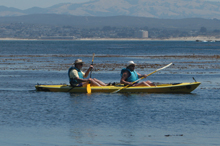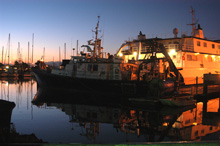The Future of Managing Our Nation's Marine Protected Areas
Marine Protected Areas (MPAs) are areas where natural or cultural resources are given greater protection than the surrounding waters. In the U.S., MPAs are found in the open ocean, coastal areas, inter-tidal zones, estuaries, and the Great Lakes. NOAA works in partnership with the Department of the Interior and other federal, state, and local partners to enhance the effectiveness of existing MPAs as a management tool and to identify areas in need of additional protection.
- Introduction
- Building the National System
- Benefits of the System
- NOAA's Role
- Conclusion
- Works Consulted

Marine protected areas provide recreation opportunities for millions of Americans each year. Click image for larger view.
Over the past several decades, the nation has witnessed a dramatic increase in the use of marine protected areas (MPAs) as conservation and management tools to protect the nation's natural and cultural resources. These resources include coral reefs, kelp forests, shipwrecks, and a wide variety of marine life in the oceans, coasts, and Great Lakes. By helping to sustain these critical habitats and resources, MPAs provide recreation and economic opportunities for millions of Americans.
As NOAA and its partners move into the future, they will continue to explore ways to define, document, enhance the use of, and evaluate the management of MPAs. Central to these efforts is the establishment of a national system of marine protected areas.
Building the National System of MPAs
Hundreds of federal, state, territorial, and tribal authorities manage more than 2,000 marine conservation areas in U.S. waters. These areas range from no-take reserves, which comprise less than one percent of the total, to areas allowing multiple uses, such as commercial fishing, angling, and boating. The duration of protection of these areas varies from just a few days to permanent. Within this broad marine conservation area grouping is the subset of U.S. MPAs, which have their own range of authorities and levels and duration of protection.

The United States is developing a national system of marine protected areas (MPA) to advance the conservation and sustainable use of the nation's vital natural and cultural marine resources. Click image for larger view.
Despite the increasing use and substantial benefits offered by MPAs, there is no consistent set of definitions and specific criteria for these areas in the U.S. There are also few mechanisms to provide assistance and coordination for the nation's MPA efforts at the ecosystem, regional, national, and international levels and across MPA programs and levels of government.
To address these needs, and as directed by Presidential Executive Order 13158, an effort is underway to develop a national system of MPAs. Development of this system is being coordinated by the National Marine Protected Areas Center (MPA Center), a cooperative effort between NOAA and the Department of the Interior (DOI). The MPA Center is working in partnership with federal, state, territorial, local, and tribal governments and other stakeholders on all national system efforts.
The first major step in this effort is the development of the "Framework for Developing the National System of MPAs." This document, developed in consultation with government partners and stakeholders, will provide common-sense guidance for cooperative efforts to develop the national system. A draft framework was released for public comment in September 2006, and the final framework is expected to be published in mid-2007.
The initial national system, as outlined by the framework, will include existing MPAs and is expected to be completed sometime in late 2007 or early 2008. Subsequent efforts, driven by partners and stakeholders, will identify shared needs for improving the effectiveness of existing MPAs and evaluate the need for future areas through cooperative planning at regional or ecosystem levels.
When complete, the national system could include national marine sanctuaries, national parks with marine components, national wildlife refuges, and federal fishery management and habitat protection areas. The system may also include sites established and managed by states, territories, and local governments, including national estuarine research reserves, which are managed in partnership with NOAA. Ongoing consultation with tribes will help to understand and guide their participation.
Enhancing MPA Stewardship and Science
As the national system of existing MPAs is established, the MPA Center and participating MPA programs will begin working together to identify and address common priorities for enhancing stewardship of MPAs in the system. Priorities may include technical assistance on issues such as management plan development, enforcement, stakeholder involvement, and/or sustainable financing mechanisms.

A national system of MPAs will provide coastal managers with an effective tool for protecting delicate marine ecosystems. Click image for larger view.
Improving regional coordination on shared management and planning priorities also helps to further ecosystem approaches to management, and leverages limited resources to maximize their impact. The national system will also bring together partners to identify and address pressing science needs. Such cooperation might include developing tools to design MPAs, investigating connectivity between areas, and building strategies to monitor MPA effectiveness.
Identifying National System Gaps and Future Conservation Priorities
A major step toward building an effective national system is the identification of gaps in existing MPA coverage and protection as they relate to goals for conservation and sustainable use of marine resources. NOAA and other MPA programs in the national system strive to use the best available science to identify priority marine resources and locations in need of enhanced or new protections.
Assessments of priority uses and impacts, threats and gaps in protection, economic effects, and opportunities to improve linkages are essential scientific information to support this process. As MPA programs and sites partner within the national system, the MPA Center will help determine the best way to identify gaps.
Evaluating Effectiveness of the National System
Once the national system is in place, NOAA and its partners will develop a plan to evaluate the effectiveness of the system, building from existing monitoring efforts already in use by MPA programs. Ensuring a sound approach for monitoring and evaluation, as NOAA does with its existing MPA programs (such as the National Marine Sanctuaries and National Estuarine Research Reserves) will provide the information necessary to adaptively and effectively manage the national system.
Benefits of the System
The national system of MPAs will help existing MPA programs and stakeholders work together to better share information and coordinate management efforts. The system will also develop scientific information needed to make more informed management decisions and to improve the stewardship and effectiveness of existing of MPAs. For example, the national system could assist MPA programs in a region that manage common species by building networks to share information on monitoring outcomes, management options, and site evaluation. Such regional coordination may also lead to sharing resources (e.g., staff or funding) among groups of MPA programs, to enhance monitoring, education or enforcement efforts.

MPAs provide safe havens for marine animals such as humpback whales.
The national MPA system will also provide a range of benefits to the nation. It will increase the efficient protection of U.S. marine resources by enhancing government cooperation and coordination on MPA issues. This cohesive framework for improving marine resource management will support the national economy by helping to maintain healthy marine ecosystems that sustain fisheries, tourism, and recreation businesses. The system will also promote public participation in MPA decision-making by improving access to scientific and public policy information.
NOAA's Role
Many partners within and outside of NOAA are working together to develop the national system of MPAs. While the MPA Center is responsible for overall coordination of the effort, the National Marine Sanctuary Program, National Estuarine Research Reserves, National Centers for Coastal Ocean Science, and National Marine Fisheries Service are key partners, both regionally and nationally.
Cooperative efforts to establish a system with existing sites will allow NOAA to work with other government agencies to build a foundation for the long-term development and implementation of the system. It also demonstrates NOAA's commitment to sound management and conservation of our ocean and coastal resources.
Conclusion
MPAs in the U.S. are managed by a host of federal, state, local, and tribal agencies and include everything from national marine sanctuaries and federal fishery management areas to estuarine research reserves and state parks. The establishment of a cohesive, coordinated framework to manage these sites is a first step in protecting marine resources.
When established in 2008, the initial national system of existing MPAs will include sites from all levels of government with a variety of conservation and sustainable use purposes. The national system will be the first of its kind in the nation, built in partnership with government agencies and stakeholders from around the country, and providing a critical tool to manage our nation's ocean and coastal resources for years to come.
Works Consulted
National Marine Protected Areas Center. (2006). Draft Framework for Developing the National System of Marine Protected Areas. Retrieved October 18, 2006, from http://www.mpa.gov/pdf/national-system/final-framework-draft.pdf
National Marine Protected Areas Center. (2006). U.S. Web site on Marine Protected Areas, Retrieved October 18, 2006, from http://www.mpa.gov
